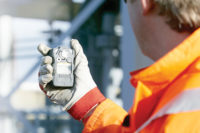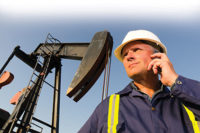At the same time, 200 miles away, a maintenance worker is walking through a chemical refinery, inspecting pipes and valves for leaks. Many of the joints and valves that are being inspected are 10-15 feet high, requiring the worker to use a sampling probe to search for the leaks.
Detecting unforeseen hazards
Workers in a variety of industries face similar situations daily. What do these scenarios have in common? Both require gas monitoring instrumentation, and both require a sampling pump to pull the air sample from the spaces around the worker, valves or fittings and deliver it to a gas monitoring device. Detecting unforeseen hazards in vaults, vessels and pits as well as inspecting lines, valves and joints for leaks is common practice in many industries today.
Remote sampling can be accomplished in various ways. A sample-draw method should be used to pull the sample from the area and deliver it to the instrument for accurate reading of the remote space. Today there are a number of instruments on the market that incorporate a pump in the instrument, or external pumps can be attached to the instrument. When using either type of gas monitoring device, there are several guidelines that should be followed.
1) Testing
As a basic safety rule, gas monitors should be tested prior to each day’s use. This simple test is commonly referred to as a bump test or function test. It consists of exposing the instrument to known concentrations of test gas and verifying that the sensors respond to gas and that the alarms are working properly.When using sampling pumps, particularly those that are external to the instrument, a step is sometimes overlooked. Daily testing of the instrument should be performed in the manner in which it is being used. If an external pump is going to be used in conjunction with the instrument, then the bump/functional test should be performed using the pump. This ensures that the pump is delivering the gas sample to the sensors appropriately, and the sensors are responding properly.
Another test that is frequently overlooked is to actually test the pump to make sure it is working properly. Most pumps and instruments today contain a method of detecting if there is a blockage in the sampling lines. If the gas sample cannot make it to the sensors due to pinched tubing or blocked filters, the instrument will not see gas. If there is a block in the delivery system, the instrument should notify the end-user with some type of alarm indication. This test is simply done by blocking the inlet to the pump and then ensuring that the instrument alerts the user of the blocked pump condition.
2) Maintenance
The biggest threats and enemies of any sampling pump are dust, dirt and water. These environmental elements can impact the performance of the pump and/or damage the pump. To combat this, many pumps contain either internal filters, external filters or a combination of both. These filters keep the dust, dirt and water from being drawn into the pump and delivered to the sensors. If dust, dirt or water reach the sensors, the instrument’s performance can be jeopardized.
These filters should be checked and replaced regularly to ensure they are not clogged or damaged. When drawing samples from pits, an external filter on the end of the sampling line should be used. This will keep water out of the end of the line if it is dropped into a liquid.
3) Patience
When sampling with pumps, users must have patience. The pump is being used to draw the sample a distance before reaching the sensors, and this takes time. The amount of time is directly proportional to the length of tubing or the length of the probe being used.
A good rule to follow is to allow two seconds per foot of tubing used. This allows ample time for the sample to be delivered to the sensors. Another good practice is to allow the instrument to draw a sample for two minutes from each location. Gases tend to stratify in confined areas. Heavier gases sink to the bottom (such as hydrogen sulfide), and lighter gases will elevate towards the top (methane). Taking measurements in each of these locations for two minutes is a good practice to ensure worker safety.
4) Integrity
The integrity of the sampling lines or probes being used should be tested and inspected for leaks or kinks. Leaks in the sampling system can dilute gas samples and give false readings to the end-user.
Testing the integrity of the system is done by simply blocking the end of the sampling line or probe to see if the pump recognizes the blockage by going into alarm. If it does not, then there is a possible leak in the tubing or probe. Visual inspection should be performed on the sampling equipment to see if there are any bad seals, fittings or punctures in the line.
5) Absorption
Certain types of tubing, such as Tygon®, absorb certain toxic gases (such as chlorine or ammonia). When sampling toxic gases, make sure the gas being sampled will not be absorbed by the tubing. Urethane and Teflon®-lined tubing are good alternatives to Tygon® because they do not absorb gases.Knowing and understanding the proper use, limitations and maintenance of sampling pumps will ensure worker safety, proper leak detection and accurate process measurements in the field.

